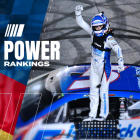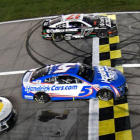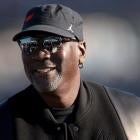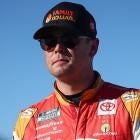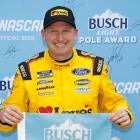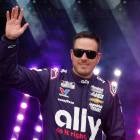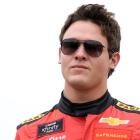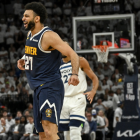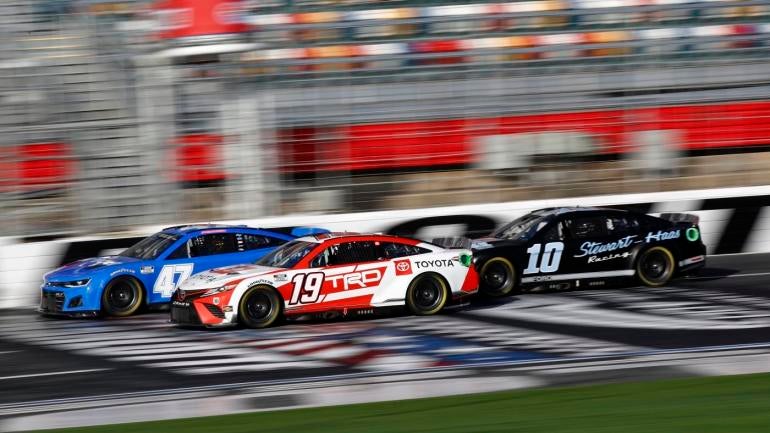
Over the past several years, a long and contentious battle has been waged in stock car racing over how much or how little horsepower the cars of the NASCAR Cup Series should feature. And after a three year tug-of-war ahead of the launch of NASCAR's Next Gen car, it looks as though those seeking more muscle under the hood are getting their wish.
During two days of testing at Charlotte Motor Speedway, NASCAR stated that they plan to use an engine output of 670 horsepower at most all tracks on the Cup Series schedule with the exception of the superspeedways of Daytona and Talladega and likely the reconfigured Atlanta Motor Speedway. The move to 670 horsepower comes after multiple seasons of Cup cars going back-and-forth between a high downforce, low horsepower aerodynamic package featuring 550 horsepower and a low downforce, high horsepower package with 750.
NASCAR had focused on 550 horsepower in part to try and entice new car makers into the sport, but the reduction in power and increase in downforce -- and its subsequent effect on the on-track product -- had become a major sore point among competitors, and fans. Speaking Friday, NASCAR Chief Racing Development Officer Steve O'Donnell indicated that 670 horsepower was "within the range" to attract a new OEM.
"We've still got kind of a few boxes to check post-test here where we get together with our (OEMs) and the teams and just confirm that's the direction we want to go with. But everything we've seen so far tells us that that's the horsepower that we want to target and go with," O'Donnell said.
According to a report by Zack Albert of NASCAR.com, race teams tested three different configurations during an eight-hour test at Charlotte on Wednesday: 550 horsepower with a centered seven-inch spoiler, 670 horsepower with a centered six-inch spoiler, and 670 horsepower with a six-inch spoiler off-center to the right.
With the amount of drag built into the Next Gen car considered, O'Donnell stated that the horsepower package would have to be so low to achieve the desired on-track results that NASCAR does not believe it to be the right course of action to pursue, explaining that 670 horsepower allows for more "comers and goers" throughout the field despite the field being more spread out at the beginning of a run as opposed to drivers being bunched together at the beginning of a run but having less overall opportunities to run cars down and make passes.
"At this point, it's just getting the drivers to a comfort level where you can run two-wide, where you have the ability to pass, and where you don't have that (aerodynamic) wake that's so noticeable," O'Donnell said.
Another test session on Friday continued the process of trying to finalize the rules package for 2022, with teams trying another configuration featuring 670 horsepower and a centered four-inch spoiler. According to Bob Pockrass of Fox Sports, lap times with the four-inch spoiler were in the low-to-mid 30 second range, which was anywhere from the same to slightly slower than with a six-inch spoiler.
Other newsworthy items from Wednesday and Friday's tests were as follows:
- According to Bob Pockrass of Fox Sports, NASCAR will allow teams to run chrome numbers in 2022, bringing back a car design feature that had been missing for some time. Despite their use in previous generations, NASCAR had disallowed the use of chrome numbers due to concerns about visibility and how they contrast with the rest of the car. Teams had run chrome numbers during Next Gen tests, prompting NASCAR to allow their return.
- RFK Racing driver and co-owner Brad Keselowski raised alarms about a shortage of Next Gen cars, as he told Daniel McFadin of Speed Sport that his team currently only has five cars in their stable. While NASCAR will allow a maximum of seven cars per individual team, a lack of chassis and chassis components caused by supply chain issues has led to concerns that RFK and other teams will not have enough cars to begin the season.
- While the Next Gen car will see parts and pieces be supplied to teams by vendors rather than be manufactured by the teams themselves, the natural impulse for teams to try and push the limits of the rulebook to seek a competitive advantage isn't likely to be quelled. O'Donnell stated that major penalties would be levied to teams that alter vendor-supplied parts, though he did not go so far as to confirm rumors that such penalties may include a potential ban from the playoffs.














